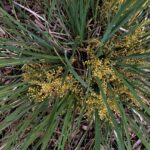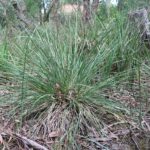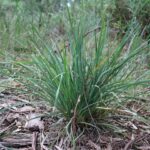Gardening with Indigenous Plants
Indigenous Plant Use
Identification & Control of Common Weeds
| Botanical Name: | Lomandra filiformis ssp coriacea 3 synonyms: Dracaena filiformis, Xerotes filiformis, Xerotes thunbergii |
| Common Name: | wattle mat-rush |
| Sold As: | Tube ($2.00) |
| Plant Type(s): | Lily, Grass Like / Strappy, Butterfly Attracting, Insect Attracting, Indigenous Plant Use |
| Indigenous Plant Use: | Nectar for food, and the leaves for basket makingCAUTION: Many plants are poisonous if not collected and prepared properly! |
| Growing Conditions: | Full Sun, Partial Shade
Sandy, Clay, Moist, Well Drained |
| Size (HxW): | 15 x 50 cm |
| Foliage: | Narrow pointed stiff blue-green to green leaves to 2-5mm wide. |
| Flowers: | Yellow flowerheads to 18cm long on fine short branches. The flowers are reminiscent of small wattle buds. Male flowers are ball-shaped, while female flowers are more tubular. Male and female flowers are on separate plants. Flowers from September to March. The fruits are roundish capsules clustered along the flower-spike. The capsules are brown when ripe. Each contains 2-3 hard seeds that are cream, brown, orange or reddish. |
| General Comments: | Lightly tufted grass-like perennial herb with a semi-arching habit, spreading by underground stems. Prefers moist sites but tolerates dry shade once established. An attractive hardy plant useful for rockeries, mass plantings and borders. Suitable for This is a low maintenance plant but may require occasional pruning to remove tattered ends. It is not subject to any known pests and diseases. Once established this species requires very little to no irrigation, making it a low water use plant. As it is slow growing it is ideal as a container plant. |
 Further Information: | |
| Plant Propagation: | https://www.greeningaustralia.org.au/wp-content/uploads/2017/11/FACT-SHEET_Lomandra_filiformis.pdf Seed collecting is from late January to late February. Monitor closely as mature seeds shed quickly Seed
L. filiformis appears to only set low quantities of seeds every 3-5 years. Soaking seeds in warm water 24 hours prior to sowing will help break their dormancy. Their germination rate is low and they can take between 4 to 12 weeks or even longer to emerge. |
This image by Macleay Grass Man, has licence: CC BY 2.0 <https://creativecommons.org/licenses/by/2.0/>





